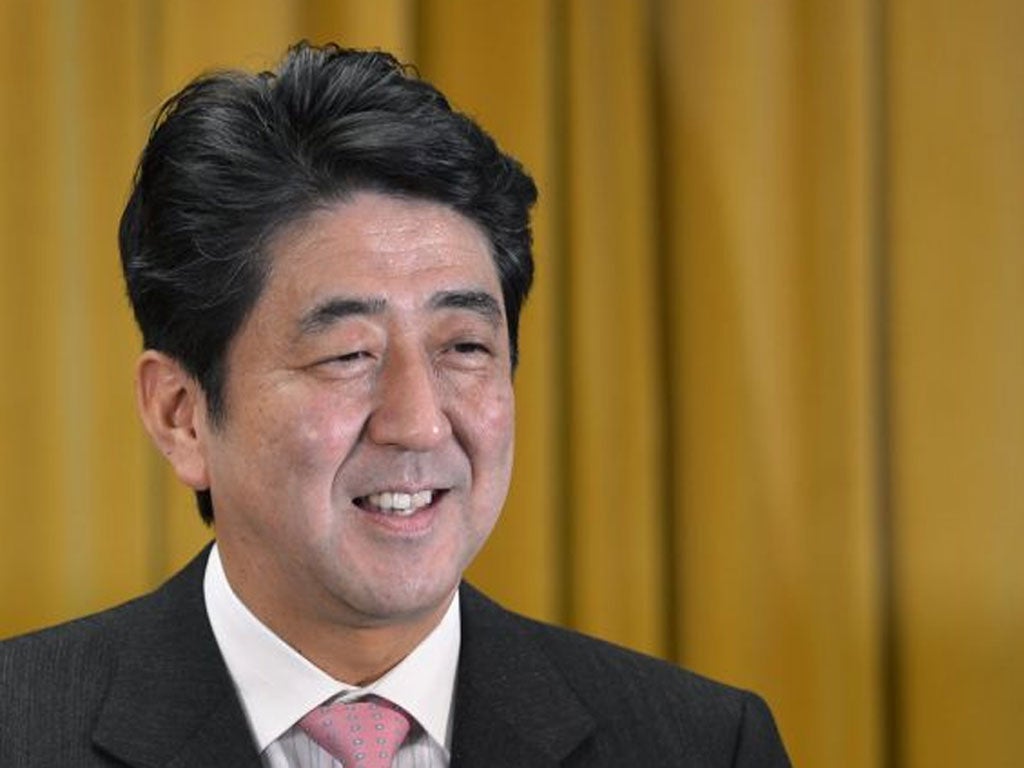Can Japan's new leader make the nation rise again?
Newly elected Prime Minister Shinzo Abe has promised to restore his country's fortunes via a huge spending drive and a more aggressive foreign policy. So could he succeed? David McNeill reports

Five years ago, Shinzo Abe tearfully quit as Japan's leader after succumbing to an ailment that left him spending long periods on the toilet. Ulcerative colitis leaves sufferers prone to diarrhoea and is worsened by stress, an unfortunate condition for a man forced to sit through long political meetings and deal with a hostile media. The sight of Mr Abe's crumpled, doleful features on national television reinforced the view that this son of wealth and privilege literally didn't have the stomach for the job.
To the surprise of many, however, Mr Abe is back, leading the conservative Liberal Democrats (LDP) to a stunning revival in Sunday's general election. The party crushed its left-leaning Democrat (DPJ) rival, which has shed two-thirds of its pre-election strength. No fewer than eight cabinet members lost seats, including the party's top spokesman and its Finance Minister.
Mr Abe's political resurrection is all the more remarkable because he appears to be offering much of the same snake-oil medicine that saw him written off five years ago: hawkish foreign-policy views abroad and public works spending at home.
The new government faces formidable challenges: an economy that has been declining for more than two decades, the highest public debt in the developed world, and a workforce that is ageing. Some of Japan's once shining corporate stars, including Sony and Sharp, are struggling with record losses. Japan's north-east, devastated by last year's triple disaster, has barely begun to rebuild. All but two of the country's 50 reactors are offline amid a bitter debate about the future of nuclear power that has raged since the Fukushima disaster.
The LDP remedy has already raised eyebrows: an ambitious increase in spending on public works, financed by aggressive monetary easing – the same pork-barrel policies that helped the party stay in power for more than half a century until 2009. Mr Abe is banking that he can jolt the world's third-largest economy out of a deflationary spiral that has plagued it for years. He is also likely to switch the nation's reactors back on and face down anti-nuclear protesters, a politically risky strategy.
Mr Abe's prescription for what he sees as declining national confidence may be even riskier. He wants to inject more patriotic education into schools and water down already sparse references to Japanese war crimes. He also hopes to realise a long-cherished conservative position by challenging Japan's pacifist constitution. Written during Japan's post-war occupation by the US, any revision would have a profound impact on Japan's already frayed relations with Beijing.
The test case for Mr Abe's pledge to somehow repair ties with Japan's biggest trading partner while staunchly defending national interests against what conservatives see as Chinese hegemony are the Senkaku Islands. China has accused Japan of "stealing" what it calls the Diaoyus during its colonial zenith, and promised to defend them, a threat backed by incursions by Chinese aircraft and boats into nearby waters. Mr Abe has staked much political capital on getting the Chinese to back off. "The Senkakus are inherently Japanese," he said in November, comparing the dispute with Britain's 1982 fight for the Falklands. "We will unambiguously protect our territory."
Seoul is unlikely to be happy with Mr Abe's election either. He has made similar pledges in relation to the Takeshimas, another group of islets (called Dokdo in South Korea) claimed by both sides. Potentially even more damaging for ties between East Asia's two most powerful democracies, he has made no secret of his determination to reverse a key government admission of guilt on an issue that infuriates South Koreans – Japan's wartime enslavement of up to 300,000 Asian women.
Mr Abe's comeback, helped by a drug that has curbed his intestinal condition, is impressive, and he is entitled to look smug. On closer examination, however, the LDP victory is not as impressive as it seems. The turnout for Sunday's poll was the lowest since the 1996 election, with 11 million fewer Japanese turning out to vote than in 2009. Millions of young people never bothered to turn up, a situation that favoured the older conservative voters who typically vote for the LDP.
To his credit, Mr Abe was candid yesterday about the electoral verdict, accepting that it was less a vote of trust in his party than an expression of despair at its predecessor. "It's their answer to the last three years of political confusion," he told NHK. "Now we have to show we have earned that victory."
Revolving door: previous leaders
Five prime ministers have come and gone since Shinzo Abe resigned in 2007. His successor, veteran politician Yasuo Fukuda, but scandal and the economic downturn forced him to resign in 2008. Then came Taro Aso, also of the LDP, whose gaffes forced him to step down in 2009. Yukio Hatoyama resigned in 2010 over a failure to fulfil campaign promises. Naoto Kan swung the vote to the centre-left Democratic Party of Japan (DPJ), but he also quit after a year amid criticism of his handling of the 2011 earthquake and tsunami. The DPJ's Yoshihiko Noda took the baton, only to hit political hurdles, paving the way for Mr Abe's return.
Join our commenting forum
Join thought-provoking conversations, follow other Independent readers and see their replies
Comments
Bookmark popover
Removed from bookmarks